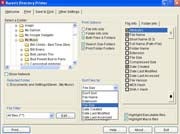Six Ways to Make Vista and XP Work Your Way
Print directory folders, dump dopey Balloon Tips, save ornery files. Plus: I debunk a bogus performance trick.
Steve Bass, PC World
Had enough of Windows' shenanigans? I'll show you how to print elegant folder lists, dispatch Balloon Tips and annoying icon wizards, and copy files that won't copy. Plus, I debunk a performance hoax that's making the rounds on the Net.
Disable Customize Notifications
The Hassle: In your last column, you explained how to hide and restore the Safely Remove Hardware icon in the System Tray. Easy for you to say--the Customize option in the Taskbar tab of the Properties menu on my PC is grayed out.
The Fix: Leave it to Microsoft to make things confusing. Right-click the Taskbar and choose Properties--'Hide Inactive Icons' is checked, right? Clear that check box, click Apply, and you're in business. And if you ever trash your system tray, grab a copy of the Taskbar Repair Tool: It's a miraculous freebie ($5 for the Pro version) that fixes dozens (36 to be exact) of taskbar, quick-launch, and system-tray problems.
Battle Balloons and Icons
The Hassle: I bought a laptop with Windows Vista (I know, silly me). The OS keeps asking to remove desktop icons, and the Balloon Tips are driving me nuts. Have a solution?
The Fix: I agree--Windows' Desktop Cleanup Wizard is ever so annoying. (Hey, Microsoft, I like my old, unused shortcuts!) In XP, you can disable the wizard with a VB script from Kelly Theriot. Grab the freebie from our Downloads library. It's safe, so ignore any security warnings. The process is easier in Vista: Right-click on the Desktop, choose Properties, Desktop, Customize Desktop, and clear the Run Desktop Cleanup Wizard Every 60 Days check box. You can ditch Balloon Tips in XP with Doug Knox's VB script; in Vista this script can be a killer, so you'll want to read the instructions on the gHacks page about it.
Print Any Folder List
The Hassle: My friend asked for a printed list of all my MP3s. I spent an hour and still couldn't figure out how to do it.
The Fix: There's an easy way to do this, and a hard way. Me, I'm lazy (it's the genes), so I use Karen's Directory Printer. The free utility generates folder and subfolder listings in every way imaginable, including (or excluding) the file size, creation date, and attributes. For you purists avoiding extra programs, Microsoft has a weekend project to print folders from your context menu in XP or Vista. Be aware, though, that it involves batch files, folder mods, and Registry hacks.
Beware This Speedup Hoax
Not everything you read on the Internet is true. I spotted a tweak--a modification of the Quality of Service (QoS) Packet Scheduler's settings--that purportedly gives both XP Professional and Vista a 20 percent bandwidth boost. I wish. I tried it, as did a few buddies. Though some of us didn't see a thing, others, me included, perceived improved performance. Unfortunately, it was merely the power of suggestion--Microsoft's experts say the tip is bogus, and I believe them. However, if you use Wi-Fi, tuning your router's QoS settings can help with some applications. Check out Becky Waring's "Optimize Wi-Fi for VoIP, Video, and Gaming" and then read Preston Gralla's "Internet Boosters" and Michael S. Lasky's helpful "Five Quick Fixes for Internet Connection Hang-Ups" for more.
Tool of the Month
Copy Stubborn Files With HoboCopy
I watched a neat Flash streaming video on a Web site and wanted to keep it to view offline. I found the file sitting in the temp folder and tried copying it to another folder. No luck--the error message 'File in use' was the only thing I saw. None of my copying tricks worked; and when I closed the browser tab that was playing the video, the file was automatically deleted. But now I've outsmarted Windows with the help of HoboCopy, an obscure, slick utility that uses Volume Shadow Service to copy files (and folders) that are in use. Once you get the hang of this command-line tool, it's easy to work with. For help, read the How-To Geek's tutorial.






0 comments:
Post a Comment